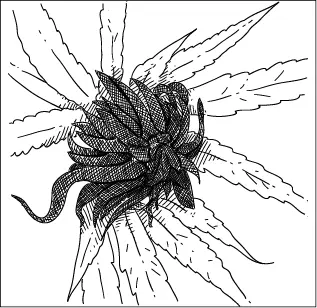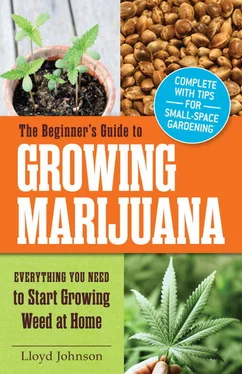Petunia
Petunias are an inexpensive and pretty flowering annual. They repel the asparagus beetle, leafhoppers, certain aphids, tomato worms, Mexican bean beetles, and general garden pests. The leaves can also be used in a tea to make a potent bug spray.
Sweet Alyssum
Sweet alyssum is a self-seeding annual that is another natural control for aphids. Alyssum flowers attract hoverflies, whose larvae devour aphids. They will reseed freely and make a beautiful groundcover every year.
Diatomaceous Earth (DE)
Diatomaceous earth is the finely ground fossils of prehistoric freshwater diatoms: tiny, single-celled algae found in plankton. DE is a fine, white, crystalline powder that is perfectly safe for humans and other mammals but deadly for garden pests. The abrasive quality of diatomaceous earth scrapes the protective outer shell off of insects. Without this protective layer, insects die very rapidly. A protective dusting of diatomaceous earth around plants will kill many insects, including slugs and fungus gnats. DE is considered a good organic gardening practice and is found at most garden centers. It kills insects, slugs, and snails within forty-eight hours of contact. Because DE is a contact irritant, use it to deplete pest populations, but still protect plants from slugs and snails by hand picking at night.
Wood Ash
Clean wood ash sprinkled around the perimeter area of a garden will deter slugs and snails, as well as supplying beneficial potash to the soil. Always make certain the ash is from a clean burn, meaning no colored papers, plastics, or other household debris is in the ash. Dyes and plastics can add toxins to your soil.
Protection from Human Pests
Another use of companion plantings is to camouflage your cannabis. Tall annuals like dill, fennel, corn, and hops vines grow very rapidly and will help screen your plants from prying eyes.
Blackberry Maze
Some rural growers make tunnels through tall blackberry growth and create small clearings for their cannabis plants. This is quite labor intensive, and frequently painful, as thorny blackberry does not give up without a fight. You will also have to pack all your soil and containers into each individual clearing, as well as plan a way to get water to the hidden plants. Hosing must be covered and hidden from aerial view; otherwise, you are creating virtual signposts right to the location where the plants are hidden.
Fencing and Camouflage
Some outdoor growers fence their cannabis, while others hide it by camouflage plantings. Both of these systems have advantages and disadvantages. Fencing needs to be high and of stout materials. This can get expensive and can alert potential thieves that you have something of value enclosed. Using camouflage is generally less expensive but can cost you your crop if casual trespassers, wildlife, or livestock come across the crop and steal it or browse it to the ground.
Timing Is Important
Even if you grow legally, it is usually wise to take plants in when it is dusk or at some point when you will not be easily observed. It is very possible that someone, like a ripper, has been watching you to see when the plants are ready.
CHAPTER 12
Dealing with Mold and Mildew
Next to cannabis thieves, almost nothing else is as detrimental to a crop as molds. Different types attack at the new seedling stage (damping off), some at the vegetative stage (the powdery type mildews), others at full flowering (gray mold, or botrytis), and, of course, the cannabis stays vulnerable during the hanging, curing, and storage phases of production. You can maximize your chances of a bountiful harvest if you follow some simple steps to prevent molds.
Healthy plants require the presence of beneficial fungi and bacteria; however, there are some pernicious versions of both that are massively destructive to your goal of successfully raising and harvesting high-quality cannabis. One of the worst molds to attack cannabis is botrytis, a pathogenic fungus also commonly known as gray mold or sometimes blight. Botrytis is found virtually everywhere plants grow and attacks many different types, not just cannabis and hemp.
This observation is not meant to be discouraging, but to emphasize how vigilant you must be in observing your plants and the need to take immediate steps to prevent and/or eradicate botrytis. As a small grower, you will have the ability to monitor all your plants very closely and provide individualized care for each of them.
How Does Mold Start Growing?
Botrytis, the most destructive mold to cannabis, must have high humidity conditions (50 percent or higher) and nutrients or some food source before it invades the plant. This is why good garden practices are important. Any debris from old leaves or bruised, broken plant parts can be enough to provide a food base. This mold is frequently found in greenhouses or indoor grow rooms, though rainy conditions near harvest can provide perfect conditions for a botrytis outbreak in outdoor crops. If ignored and left unchecked, eventually the fungus will invade healthy plant tissue, and you will lose a significant portion, or even all of, your harvest.
To help prevent infection, monitor each plant on a daily basis for the following problems, and remove or repair:
• Fallen leaves, at base of plant, or hanging on axials
• Injured leaves
• Broken stems
• Cuttings from botrytis-infected plants
• Wounded tissue where cuttings were taken
Botrytis is spread by the wind, in water, or on your hands or clothing. Almost any activity can result in a release of spores and subsequent transfer to the crop. Botrytis initially forms two types of resting structures on or in infected plant tissue. The fungus then waits for the right high-humidity condition to erupt into destruction mode.
What Does Mold Look Like?
Botrytis appears sometimes within hours of a plant inspection. The reason for the common name of gray mold becomes apparent when you first see the gray, smoke-like eruptions of spores appear on the flowers of your prized plants. Unfortunately, the mold starts from within the flower, so your first indication of botrytis can be only the tip of the iceberg. The mold can initially be mistaken for a dusting of trichomes, but once in full bloom it presents as gray, almost hairlike, spots on the cola or flower, continuing rapidly to a slimy, dark gray mess.

Botrytis starting on a flower. Notice the mold spot.

Full-blown botrytis.
Mold Prevention While Growing Cannabis
Sanitation and good air circulation are the best weapons the grower has to prevent major botrytis or other mold outbreaks. Remove dead leaves or damaged tissue from the plants and keep the garden area extremely clean. Do not throw dead leaves to the base of your plants; you are only creating a food source for botrytis and other molds. If you have plant breakage or cut tissues (from accident, high winds, or taking cuttings for propagation), repair immediately.
You will note that cannabis stalks and stems appear hollow inside. Water can collect where the plant has been injured or cut and provide a nice damp spot for mold to start. It is worth your while to seek out some pure beeswax (for the best price, check online for local beekeepers to buy from, or you can purchase at health food stores or candle making shops).
Читать дальше














